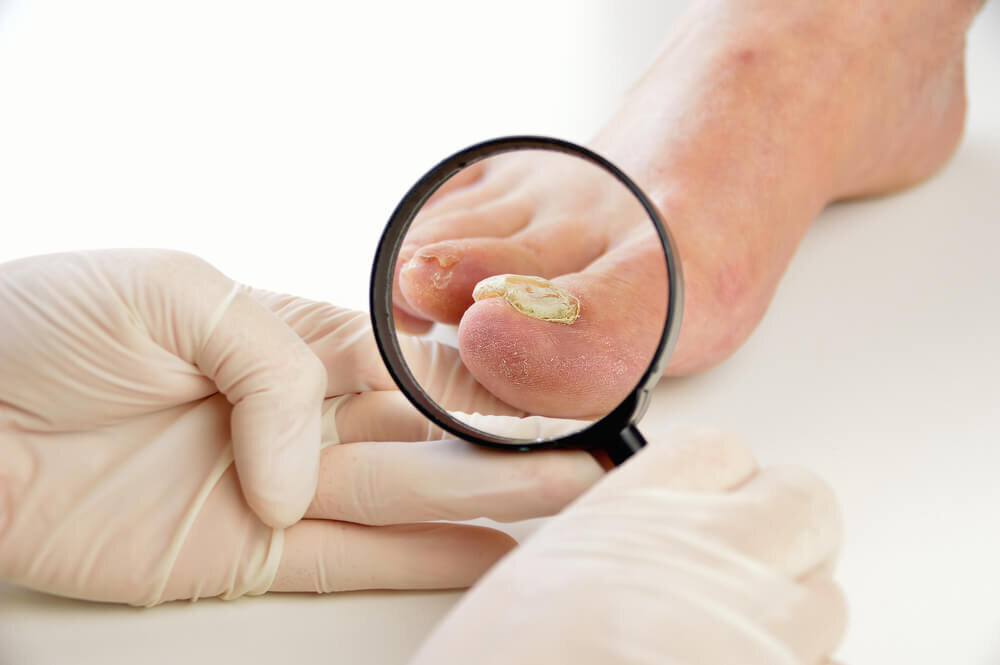Toenail Disorders
Toenail Doctor, Podiatrist in Gulfport, Gautier, Laurel & Hattiesburg, MS
Toenail Fungus
MANY TOENAIL FUNGUS TREATMENT OPTIONS, INCLUDING LASER
An infection of nail fungus occurs when fungi infect one or more of your nails. A nail fungal infection may begin as a white or yellow spot under the tip of your fingernail or toenail. As the nail fungus spreads deeper into your nail, it may cause your nail to discolor, thicken and develop crumbling edges — an unsightly and potentially painful problem. An infection with nail fungus may be difficult to treat, and infections may recur. But medications are available to help clear up nail fungus.
You may have a nail fungal infection — also called onychomycosis (on-i-ko-mi-KO-sis) — if one or more of your nails are:
Thickened
Brittle, crumbly or ragged
Distorted in shape
Dull, with no luster or shine
A dark color, caused by debris building up under your nail
Infected nails also may separate from the nail bed, a condition called onycholysis. You may feel pain in your toes or fingertips and detect a slightly foul odor. Fungi are microscopic organisms that don't need sunlight to survive. Some fungi have beneficial uses, while others cause illness and infection. Nail fungal infections are typically caused by a fungus that belongs to a group of fungi called dermatophytes. But yeasts and molds also can be responsible for nail fungal infections. All of these microscopic organisms live in warm, moist environments, including swimming pools and showers. They can invade your skin through tiny invisible cuts or through a small separation between your nail and nail bed. They cause problems only if your nails are continually exposed to warmth and moisture — conditions perfect for the growth and spread of fungi. Infection with nail fungus occurs more in toenails than in fingernails because toenails are often confined in a dark, warm, moist environment inside your shoes — where fungi can thrive. Another reason may be the diminished blood circulation to the toes as compared with the fingers, which makes it harder for your body's immune system to detect and eliminate the infection.
There are currently 3 treatment modalities for this condition. They include topical medications, oral medications, which can have some serious side effects; and the newest modality which is laser therapy. At Dr. Edward R. Cohen Podiatry in Gulfport, Gautier, Laurel & Hattiesburg, Mississippi we use a laser, which focuses a concentrated beam of laser light through the nail to eradicate the fungus living under and in the nail. The procedure is performed right in our office, requires no anesthesia and is painless. Most patients require only three treatments and can once again enjoy wearing open toed shoes. If you're tired of looking at those unsightly toenails, please contact our office to determine if you are a candidate for laser therapy.
Ingrown Toenails
Many of our patients fear coming in for treatment of an infected ingrown toenail. They come in with excruciating pain and we will get to send them home feeling a whole lot better.
An ingrown toenail occurs when a corner of the nail grows into the flesh of the toe, causing redness and swelling, followed by pain and often infection. Ingrown toenails can occur due to improper trimming of the toenail, trauma or genetic factors.
Treatment for ingrown toenails is performed by gently numbing the toe, and then removing the offending corner of the nail. If you have chronic ingrown toenails we can apply a chemical to the nail root to permanently prevent the re-growth of the ingrown portion of the nail. Patients are typically back into a shoe and can resume their normal activities almost immediately.
If you have an ingrown toenail, don't be afraid to come into our office, contact Dr. Edward R. Cohen Podiatry today. Your treatment will be gentle and virtually painless, and we'll get you back to your normal activities right away.


